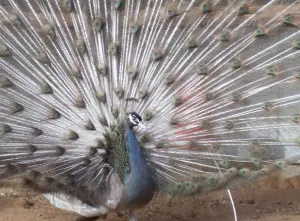
Opal peafowl, scientifically known as Pavo cristatus, are a subspecies of the Indian peafowl. They are distinguished by their opalescent plumage, which gives them a mystical appearance.
Opaline peafowl possess a captivating blend of shimmering colors that change when viewed from different angles, making them a sight to behold.
Physical Characteristics of Opal Peafowl
Opal peafowl share many physical traits with their Indian peafowl relatives. The males, known as peacocks, are larger and more vibrant in color than the females, called peahens.
The opalescent feathers of peacocks feature a range of hues, including iridescent blues, greens, purples, and even hints of gold. The majestic train of a peacock, consisting of elongated upper tail coverts, is a symbol of their grandeur and is used in courtship displays.
Habitat and Distribution
Opal peafowl are native to the Indian subcontinent, particularly found in India and Sri Lanka. They inhabit various habitats, including dense forests, grasslands, and agricultural areas. These adaptable birds have also been introduced to other parts of the world, such as North America and Europe, where they are admired for their beauty and grace.
Behavior and Lifestyle
Opal peafowl are diurnal birds, meaning they are most active during the day. They are social creatures and are often found in small groups known as parties. Peafowls are omnivorous, feeding on a diet that includes insects, small mammals, reptiles, grains, fruits, and vegetation. Their distinct calls, a combination of squawks and melodious cries, are a part of their communication repertoire.
During the breeding season, male opal peafowl showcase their vibrant plumage to attract mates. Their courtship displays involve fanning out their extravagant train feathers, erecting their crest, and performing a dance accompanied by rhythmic calls. The peahens, with their more modest appearance, carefully observe these displays before choosing their preferred mate.
Significance and Symbolism
Opal peafowl hold cultural and symbolic significance in various societies. In many cultures, the peacock symbolizes beauty, immortality, and protection. Their resplendent plumage has been used in fashion, art, and religious ceremonies throughout history. Opal peafowl are often associated with qualities like pride, elegance, and rejuvenation, making them a beloved symbol in mythology and folklore.
Conservation Status
Opal peafowl, like their Indian peafowl counterparts, are not considered endangered. However, habitat loss and fragmentation pose threats to their populations. Conservation efforts are essential to ensure the continued survival and protection of these magnificent birds.
Initiatives focusing on habitat preservation, captive breeding programs, and raising awareness about their ecological importance play a vital role in safeguarding the opal peafowl for future generations.
FAQs
Q1: How do opal peafowl achieve their iridescent plumage?
Opal peafowl possess unique feather structures that diffract light, resulting in the iridescent colors seen in their plumage.
Q2: Can opal peafowl fly?
Yes, opal peafowl can fly. However, their flight is limited and primarily used for short distances or to escape from predators.
Q3: Are opal peafowl kept as pets?
Opal peafowl are sometimes kept as pets in spacious aviaries or estates with suitable habitats to accommodate their needs.
Q4: Do opal peafowl have any natural predators?
Opal peafowl face threats from natural predators such as large birds of prey, wild cats, and snakes.
Q5: What is the lifespan of opal peafowl?
Opal peafowl have an average lifespan of 15 to 20 years in the wild. However, under optimal conditions in captivity, they can live beyond 25 years.
Conclusion
Opal peafowl, with their captivating opalescent plumage and enchanting courtship displays, are truly a gem among avian species. Their mystical beauty, cultural significance, and diverse habitat make them a subject of fascination for bird enthusiasts and nature lovers alike.
By appreciating and protecting these magnificent birds, we can contribute to the preservation of their extraordinary legacy.